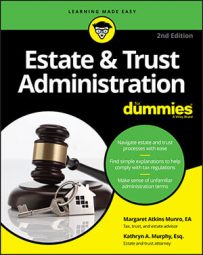After death, the rules governing receipt of income in an estate and the payment of its expenses loosen up somewhat. It’s not as though the electric company can threaten the decedent with shutting off the power.
Because the standard sanction of “you don’t pay, we don’t provide” doesn’t carry any weight with an estate, you have an opportunity to place at least some of your income, deductions, and expenses in years, and on tax returns, where they’ll save the greatest amount of income tax across all affected returns.
You can use these strategies by themselves or in any combination to minimize the total income tax bill generated by the estate or trust.
How to benefit from the estate’s fiscal year
In general, taxpayers must use a calendar year as their tax year, with a few exceptions. The biggest of these exceptions exists for estates, which may choose any tax year-end so long as the estate’s first tax year is no longer than 12 months.
If you choose a fiscal year-end that isn’t December 31, the information on any K-1 that results from that tax return isn’t reported by the recipient until the end of the recipient’s tax year. If your decedent dies in February of one year, you can opt to end the estate’s tax year in any month from the end of February all the way through to January of the following year.
If you suspect that the estate will take more than 1 tax year to complete, or you think that the income from the estate would be better split between 2 years, you may choose to have a short first year, make sure that you receive only as much as you plan to pay out in deductible expenses, and have that first tax return show little or no income being taxed.
On the other hand, if there’s nothing much at all to the estate and you just want to prepare one income tax return for it, do your best to make sure that all items of income have been received and all the deductible expenses have been paid in that one year.
If you chose a fiscal year for the return and taxable income is being passed out to the estate beneficiaries, that income won’t be reportable by the beneficiaries until the calendar year that coincides with the estate’s fiscal year-end.
How to balance the estate’s taxable income against the beneficiary’s
Inevitably, money will leave an estate and move down to the beneficiary. The only question is when that move occurs. An estate, by definition, is a short-lived entity, existing only to affect the transfer of property from the decedent to his or her heirs. The timing of those property transfers can carry significant tax benefits for both the estate and the beneficiary.
Both the estate and the beneficiary are taxed at the lowest rates on the first dollars of income they receive. As they pay on more dollars of income, the rate of tax gradually increases, finally arriving at the top marginal bracket, which is 39.6 percent in 2013.
But, when you’re administering an estate, you have not only the estate’s bracket run but also the beneficiary’s. Although an estate’s tax brackets escalate much more quickly than an individual’s (you hit the top rate of 39.6 percent at a measly $11,950 of income in 2013), take advantage of that bracket run if you can.
If there’s taxable income in the estate, make sure that you pay some of it out to the beneficiary before the end of the estate’s tax year-end, if at all possible. This way the beneficiary will pay any income taxes due on the money he or she receives, and the estate will only pay taxes on the income that’s left in the estate.
Make sure that you check with the estate’s beneficiaries before you make distributions out to them; they won’t thank you if they’re pushed into a higher tax bracket because of it. Work with them to determine when would be the most advantageous tax year for them to receive this income; then make that date your target date for distribution.
How to time the receipt of income
There may be absolutely no way in the world for you to hold off receiving money that represents income to the estate. For example, that last paycheck will be paid on schedule, and the life insurance proceeds, which include some taxable interest, may show up when you least expect them. But you can arrange for certain types of income to arrive in an advantageous tax year.
Pay the ongoing expenses of the estate
Just like timing income receipts, often you can also time when you pay the estate’s expenses. Obviously, some expenses are paid only once, such as filing fees for probate, funeral expenses, and even final medical bills. Then there are the expenses that arise month after month, such as the costs of keeping the decedent’s home heated and the lawn mowed.
These are necessary expenses of the estate insofar as they’re required to keep a major asset in saleable condition and are therefore deductible on the estate tax return. Keep your eye on those annual fees, such as accounting fees, which can be slightly anticipated or delayed in order to coincide with the receipt of large chunks of income into the estate, reducing the estate’s taxable income to little or nothing.
If you aren’t using the estate’s deductions on its Form 706, and those payments will be deductible on Form 1041, make sure that you have taxable income in the estate before you decide to pay your executor’s fee or your accounting professional’s fee.

